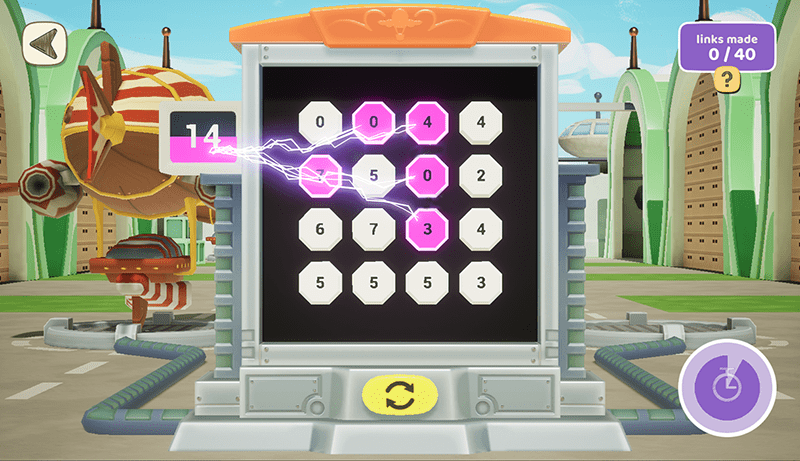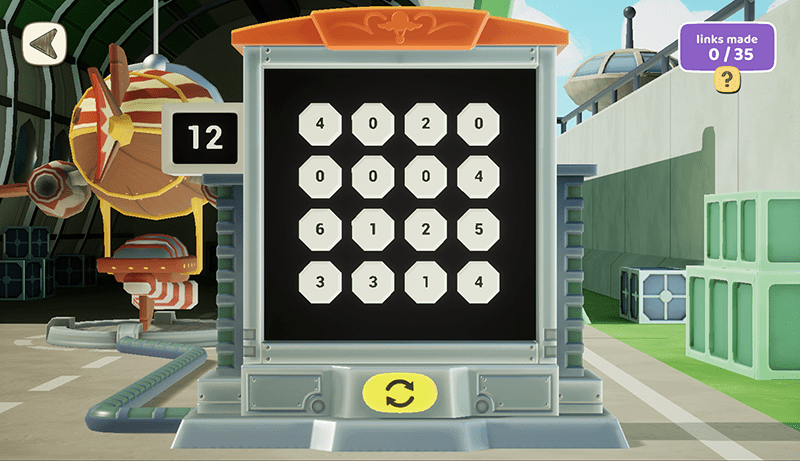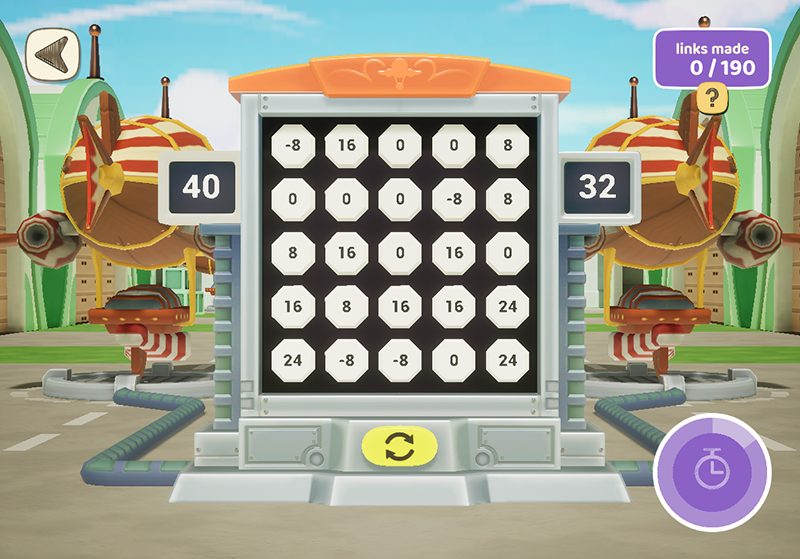Back to library
Maths in Town Squared: combining numbers in the Airport
About these maths activities
In these activities, children link numbered power cells on a grid to help charge up airship batteries. Each grid displays different numbers to encourage children to think flexibly about addition, subtraction, and the relationship between repeated addition and multiplication.

An Airport - Single Charger activity is in progress. A chain of numbered power cells matching the target number have been linked. Electric bolts are moving from the number cells to the target number.
Each airship needs a different amount of charge, shown as the target number on the side of the console. Children look for a combination of numbers on the grid that match the target number and drag across the numbers to link them together.
Links can only be made between power cells that are next to each other (up, down, left, right, and diagonal). If a child feels stuck, a reset button below the grid loads a new set of numbers. Each grid is designed to show common number bonds that make the target number, so repeated play helps children practise and memorise the combinations.
Linking numbers of the right amount will send a charge of energy to the airship battery, and it 'fills up' a little bit at a time. When the battery is full, the ship charges up and moves away, and a new one arrives to repeat the process. Completing the required number of links earns the player a quest ticket.
Some activities in Airport include a gentle timer to encourage children to move on from counting, which is time-consuming, to recognising and linking common number bonds without counting. Most levels allow plenty of time, and running out of time has no penalty as the game simply resets to play again. By setting a goal, children are more likely to repeatedly play the level, and this practice over repeated turns helps embed number combinations in long-term memory and improve recall.
There are three activities in Airport, each with a different level of challenge.
Repair dock
This activity uses target numbers ranging from 4 to 100. There is no timer in this activity, so the puzzles can be done by children of all abilities.

An Airport - Repair dock activity is set to go. The target number is 12 and a 4x4 grid of numbers is ready to link up. It has no timer, for children who prefer to find the solutions at their own pace.
Single charger
This activity starts with targets as low as 5 and going as far as 250. Focuses on addition and multiples. This activity introduces a gentle timer to encourage mental maths skills and the process of committing common number combinations to memory.

An Airport - Single Charger activity is set to go. The target number is 14 and a 4x4 grid of numbers is ready to link up. The timer has begun.
Double charger
This activity requires charging two ships at the same time (each with a different target to reach) and introduces negative numbers, so links may require addition and subtraction. Negative numbers start small (eg -2), until children are eventually combining numbers between -30 and 75 to make totals up to 175. This activity includes a timer, starting with lots of time on the clock and gradually ramping the challenge.

An Airport - Double Charger activity is set to go. The target numbers are 40 and 32 and a 5x5 grid of numbers is ready to link up. Double Charger activities have negative numbers in the mix.
Information for teachers and educators
How does this puzzle relate to the Cambridge Big Ideas in Mathematics?
Cambridge University developed the Cambridge Big Ideas in Mathematics, based on concepts proposed by Randall I. Charles1. The Big Ideas described below help represent and teach maths as a connected and coherent area of learning, and they underpin the design of puzzles in Town Squared.
Big Ideas 1 and 2: Numbers and the base 10 numeration system
‘The set of real numbers is infinite; each real number can be associated with a unique point on the number line. The base 10 numeration system is a scheme for recording numbers using digits 0-9, groups of ten, and place value.’
In the Airport, children can:
- Combine whole numbers to make larger numbers, starting by combining 1s to create single digit totals and gradually scaling up and down the number line, using positive and negative numbers to create three digit totals.
- Combine groups of 2, 5, and 10 to create a larger number, using skip counting in both even and odd numbers.
- Incorporate zeros in their combinations, and see that adding a zero to the links does not increase the total.
Big Idea 5. Operation meanings and relationships
‘The same number sentence (e.g. 12-4 = 8) can be associated with different concrete or real-world situations, AND different number sentences can be associated with the same concrete or real-world situation.’
In the Airport, children can:
- Link up numbers to create a larger target number, starting with combining single digits to make familiar target numbers (eg 5, 10)
- Look at a grid of numbers and see how the same numbers can be combined in different ways to form that target number.
- Practise mentally partitioning and combining with increasingly large numbers. Scale and improve their skills by making unusual target numbers, or through the presentation of different digits to achieve the same target number.
- Combine larger double-digit numbers with negative numbers, using addition and subtraction to achieve the target number.
- Combine multiples of a number to achieve the target number (eg: 6+6+6 is 3x6=18).
- Extend multiplicative thinking to explore how different multiples will achieve the same target number (eg: 18 can be made by combining 3 sixes, 2 nines or 6 threes, or by combining 12 and 6).
- Increase their fluency with operations, by repeatedly playing to achieve the goal and receive the in-game rewards.
How do the activities scale in complexity?
There are three activities, each of which comprises a range of target numbers and grid configurations that slowly ramp up the challenge to complete. Overall, the series of three activities are intended to follow on and extend from each other in terms of complexity.
Scaffolding is built into the level designs, as early levels introduce skip counting and multiplicative thinking with simple target numbers, and subsequent levels build on this.
The three activities are:
- Repair dock: foundation puzzles that start with single digits and slowly introduce the use of zero and skip counting, finishing with simple multiplicative thinking towards higher levels. This activity does not include any timing, so children of all abilities can begin here.
- Single charger: also starts with single digit puzzles and gradually increases complexity, moving to multiplicative thinking earlier and building on that with higher target numbers and larger multiples (eg: 6+6+6+6 to make 24). This activity uses a gentle timer, with all but the highest levels allowing plenty of time to complete a puzzle.
- Double charger: the most complex puzzles with challenging targets and grids, including multiplicative thinking and negative numbers. Children may choose to work on two ships at once (exploring how the same numbers can be combined to make different totals) or simply complete one ship at a time. The timer gradually increases the challenge and encourages repeated play to achieve the goal.
All three activities can be accessed by all players at any time, so children can explore and experiment and so teachers can direct them to different types of challenge.
All activities are designed with a ‘low floor, high ceiling’ approach: entry level puzzles are very simple and establish the ‘low floor’ of difficulty, allowing children to learn how the puzzle works. Over the course of the activity the puzzles progressively scale up in complexity, or scale back if the child has difficulty completing a particular level.
When a child successfully completes a few puzzles at one level, they will automatically be presented with a set of puzzles from the next level up on their next try. If a child makes an unsuccessful attempt at a puzzle they will be given feedback on their approach, directed to the help text and encouraged to try again. If they make multiple unsuccessful attempts, they will automatically be presented with puzzles from a lower level of complexity on their next try. This is intended to ensure that children aren’t discouraged by being repeatedly presented with puzzles that are too complex for them, and to help teachers identify the challenge point for that child.
In puzzles with timers, children are also rewarded with time and points bonuses for longer links, which encourages them to seek out different combinations. When a child reaches the highest level, the game continues, providing previous puzzles at random.
Repair dock activity
The Repair dock activity covers creating number chains that add up to totals ranging from 4 to 100. It starts with simple addition puzzles that require 2-3 links on a 3x3 number grid to reach the target score. The higher levels may require 5-6 links on a 5x5 number grid to achieve the score. These puzzles don’t use a timer, so children of all abilities can complete each puzzle at their own pace.
Puzzles are grouped into levels of difficulty, and scale up from this ‘low floor’ as follows:
- Lower levels – low target scores, 3x3 or 4x4 grid
- Mid levels – mid target scores, 4x4 or 5x5 grid
- Higher levels – high target scores, 5x5 grid.
Each level introduces new targets, while reusing some of the skip counting skills shown in previous levels.
|
Difficulty level |
This group of puzzles addresses these concepts |
|
Level 1 |
Combine numbers between 0-5 to reach targets up to 16, without a time limit; includes skip counting in 2s. |
|
Level 2 |
Combine numbers between 0-10 to reach targets up to 21, without a time limit; includes skip counting in 2s, 3s and 5s. |
|
Level 3 |
Combine numbers between 0-10 to reach targets up to 50, without a time limit; includes skip counting in 2s, 3s and 5s. |
|
Level 4 |
Combine numbers between 0-10 to reach targets up to 42, without a time limit; includes skip counting in 2s, 3s and 4s. |
|
Level 5 |
Combine numbers between 0-21 to reach targets up to 100, without a time limit; includes forming larger numbers in 2s, 3s and 5s, and working with multiples of 6s and 7s. |
Total number of puzzles: 25
Single charger activity
In the Single charger activity, children create number chains that add up to between 5 and 240. It starts with simple addition puzzles that require 2-3 links on a 3x3 number grid to reach the target score. The higher levels may require 5-6 links on a 5x5 number grid to achieve the score. A gentle timer encourages children to practise mental maths skills and gradually commit common number combinations to long-term memory.
Puzzles are grouped into levels of difficulty, and scale up as follows:
- Lower levels – low target scores, 3x3 or 4x4 grid
- Mid levels – mid target scores, 4x4 or 5x5 grid
- Higher levels – high target scores, 5x5 grid.
Each level introduces new targets, while reusing some of the skip counting skills shown in previous levels. The target numbers are a little higher than Repair dock. This, combined with a time limit for completion, provides an extra level of complexity.
|
Difficulty level |
This group of puzzles addresses these concepts |
|
Level 1 |
Combine numbers between 0-7 to reach targets up to 15, with a gentle timer; includes skip counting in 2s. |
|
Level 2 |
Combine numbers between 0-10 to reach targets up to 45, with a gentle timer; includes skip counting in 2s, 3s, 4s and 5s. |
|
Level 3 |
Combine numbers between 0-12 to reach targets up to 50, with a gentle timer; includes more complex skip counting with 2s, 3s, 4s and 5s. |
|
Level 4 |
Combine numbers between 0-18 to reach targets up to 81, with a gentle timer; includes more complex skip counting in 2s, 3s and 9s, plus skip counting in 2s using odd numbers (1,3,5,7,9). |
|
Level 5 |
Combine numbers between 0-60 to reach targets up to 240, with a gentle timer; includes working with multiples of 15s, and forming larger numbers with 2s, 3s, 4s and 5s. |
Total number of puzzles: 25
Double charger activity
The Double charger activity has totals between 4 to 120 (a smaller range than Single charger, as the game introduces negative numbers to the mix). It starts with a 4x4 number grid, but quickly moves to 5x5, requiring on average 4-8 links to reach the target. As with Single charger, mental maths skills and memorising number combinations are encouraged through a timer.
Puzzles are grouped by level of difficulty, and each one scales up from the last. The target numbers are a little higher than the Single charger activity. This, combined with negative numbers and a choice of two ships to charge, provides extra levels of challenge.
Each level introduces new target numbers, while reusing some of the skip counting skills shown in previous levels.
|
Difficulty level |
This group of puzzles addresses these concepts |
|
Level 1 |
Combine numbers between -5 and 15 to reach targets up to 30, with a gentle timer and two targets at a time; includes skip counting in 2s, 3s and 5s. |
|
Level 2 |
Combine numbers between -5 and 20 to reach targets up to 45, with a gentle timer and two targets at a time; includes more complex skip counting in 2s, 3s and 5s. |
|
Level 3 |
Combine numbers between -6 and 20 to reach targets up to 50, with a gentle timer and two targets at a time; includes more complex skip counting in 2s, 5s and 6s. |
|
Level 4 |
Combine numbers between -25 and 75 to reach targets up to 175, with a gentle timer and two targets at a time; includes working with multiples of 4s, 7s, 8s, 9s and 25s. |
|
Level 5 |
Combine numbers between -30 and 75 to reach targets up to 120, with a gentle timer and two targets at a time; includes working with multiples of 3s, 8s, 9s and 15s. |
Total number of puzzles: 25
How do these activities improve disposition towards maths and learning?
Mental maths keeps our brains sharp, improves our sense of number, and helps us to understand the relationship between different quantities. More broadly, mental maths also helps develop a child’s concentration, memory, and problem-solving skills, all of which builds maths confidence.
The Airport activities are designed not only to strengthen a child’s mental maths skills, but show that you can use different combinations to reach the same total, including zero and negative numbers. Skip counting and multiplicative thinking helps children work flexibly and efficiently with larger numbers.
Mental maths skills help us function in our daily lives in situations such as shopping and cooking. It also provides the foundation to understanding mathematical concepts instead of simply memorising them.
The activities allow children to formulate and test different strategies to solve a puzzle, use feedback to think through a strategy, and ‘learn by doing’. These strategies may help a child reach the answer, or they help achieve long-link bonuses. These activities also reward a child in-game, through earning tickets for effort, allowing them to go on quests.
Examples of strategies within the activities include:
- grouping numbers into ‘10 facts’ (eg 5 and 5, 4 and 6, etc)
- skip counting (eg 2-4-6-8-10)
- multiplicative thinking, for example adding multiples of 6 to get a total. Such as 12 (two sixes) and 18 (three sixes) to make 30 (5 sixes total).
- using zeros as a link to a required number or to increase the chain length, without affecting the overall total
- using cancelling positive and negative numbers (eg 5 and -5) as a link to a required number to increase the chain length.
This allows a child to experiment with number patterns, encourage mental maths skills and gradually commit common number combinations to memory.
Feedback is instantaneous - a successful link chain powers up the battery - an unsuccessful attempt doesn’t.
- In the Repair dock, longer link chains are rewarded with bonus points to reach the goal quicker. There is no consequence for an unsuccessful attempt beyond continuing the activity. This approach helps to reduce negative associations with ‘getting it wrong’, which can feed into maths anxiety. If a child chooses to leave mid-game a number of times, they will be scaled back to a level where they previously experienced success.
- In the Single and Double charger activities, longer link chains are rewarded with time and bonus points to reach the goal quicker. The only consequence of an unsuccessful attempt is lost time. If the game times out, the child is encouraged to keep practising. If a child times out on a level twice, they will be scaled back to a level where they previously experienced success.
All activities include a Help button. This can be accessed at any time during play and provides instructions the child can use to complete the activity.
References
Charles, Randall I., (2005). Big ideas and understandings as the foundation for elementary and middle school mathematics. Journal of Education Leadership, 7(3), 9-24. Available from: https://www.jaymctighe. com/wp-content/uploads/2011/04/MATH-Big-Ideas_ NCSM_Spr05v73p9-24.pdf
